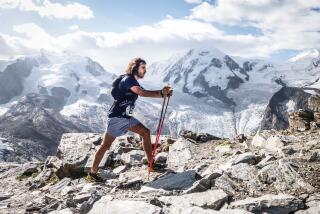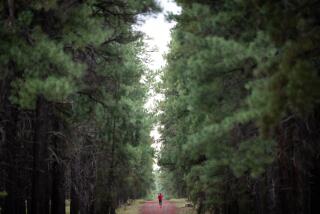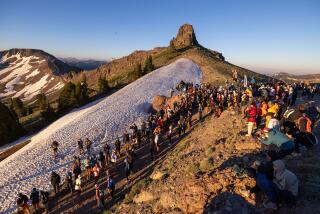Moments of Watching, Hours of Waiting : Cycling: For those staffing time stations in the Race Across America, chances to get involved are few and far between.
DALHART, Tex. — Rodney White opened time station No. 21 at 1:30 a.m. (PDT) Thursday.
He was just in time to watch Rob Kish, the leader in the Race Across America, pedal past in the darkness. With a blue magic marker, White wrote down Kish’s name and the time he passed on a makeshift leader board. A moment later he picked up a phone and called in Kish’s time to RAAM headquarters at the Downey Cyclery.
And then White waited.
Sometime around 4 a.m., John Marino, RAAM’s race director, drove up in the officials’ van to say hello and make sure everything was in order.
At 4:14 a.m., Bob Fourney, riding in second place, rolled into and out of the station.
And White waited some more. Almost 90 minutes later, Al Muldoon, in third place, slipped past.
Around 8 a.m., without a fourth-place rider in sight, White shut the door and went to work for a few hours.
By noon he was back. Richard Fedrigon’s advance crew was there, plotting its next move. But Fedrigon, in fourth place, was still almost 100 miles from Dalhart.
The riders had passed 20 time stations over more than 1,200 miles before rolling into the Texas panhandle town of Dalhart. In all, there are 49 stations, some manned and some not, between the start last Sunday in Irvine and the finish in Savannah, Ga.
In Desert Center, Calif., time station No. 2 was at Mike Karr’s recreational vehicle parked at an Interstate 10 off-ramp. In Flagstaff, Ariz., No. 6 was in a gravel lot next to Maverik Country Store. At Mexican Hat, Utah, No. 10 was the San Juan Motel.
None, however, has been located at an old railroad caboose.
Just past Hardee’s restaurant on U.S. 385, sharing the same parking lot, is Dalhart’s visitors center--a bright red caboose.
Script letters read: Discover Dalhart Texas.
Across the street is the Nursanickel Motel. Many crews, and even a few riders, will grab a shower and sleep there for a few hours.
White, Dalhart’s 39-year-old chamber of commerce director and resident cycling nut, has set up shop in the town’s most distinctive landmark.
He and four others will rotate shifts at the caboose, recording times, giving road and weather updates and yelling encouragement, until the last rider has passed. It’s the only method of keeping track of the cyclists’ cross-country progress.
“I just hope I don’t miss anyone,” said White, who also ran the Dalhart time station last year.
This far into the 2,922-mile race, the riders have opened huge gaps among themselves. One of the tricks to operating a time station is whiling away the hours between riders.
“I guess we’ll just study the history in this caboose,” said Jeannie Hutchison, one of White’s assistants. “I’m a lifelong Dalhart resident and I’ve never been in it (the race) before today.”
A few moments later, a traveler climbed the steps of the caboose asking for directions to a Mexican restaurant.
“Well, you go back here a block, then turn at Main, then go about three blocks to Third and it’s on your left,” Hutchison said.
It seems there will be plenty for her to do for the next three days or so.
Most time stations are run by local bicycle racers like White and Hutchison, who can stay at home during their off hours.
Back in Flagstaff, that was not the case. Time station No. 6 was operated by members of a cycling club in Tucson, a six-hour drive in a car.
Richard DeBarnardis, the club’s director, led three others up Interstate 17 Monday morning. He was planning to give each rider who made it to Flagstaff a commemorative medal and give a trophy to the first man and woman to reach Flagstaff.
But somewhere outside Phoenix, the engine in his car blew. He stopped for repairs while three others continued in another car without him.
Sue Srader took over as the time station chief, welcoming the riders with medals.
As night fell, a strong wind came up and the temperature began to drop and the crew bundled up for their first night of RAAM. Some went to a nearby motel to sleep and stay warm for the day shift.
Their hardship hardly seemed mentioning when you compare it to the RAAM riders’ trials and tribulations.
“I know by Wednesday I’ll be back home in Tucson,” Srader said. “The riders have to keep on going.”
The riders passed frequently, still bunched tightly after 501.9 miles. There didn’t seem time to get bored, not with Srader’s cheerleading each time a rider passed.
“We got here early, so we drove back to Williams (40 miles west of Flagstaff on I-40) to cheer the riders,” she said. “They didn’t know who we were, but they got so excited when we’d pass by, waving and honking.”
By Wednesday morning the field had passed and time station No. 6 had closed. Srader and her co-workers were back home in Tucson.
More to Read
Sign up for The Wild
We’ll help you find the best places to hike, bike and run, as well as the perfect silent spots for meditation and yoga.
You may occasionally receive promotional content from the Los Angeles Times.






